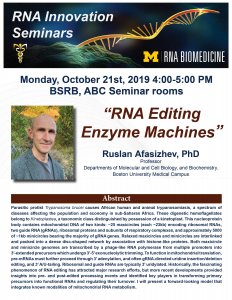Presented By: Center for RNA Biomedicine
RNA Innovation Seminar, Ruslan Afasizhev, Boston University Medical Campus
"RNA Editing Enzyme Machines"

Ruslan Afasizhev, PhD, Professor, Molecular & Cell Biology, Boston University Medical Campus
Abstract: Parasitic protist Trypanosoma brucei causes African human and animal trypanosomiasis, a spectrum of diseases affecting the population and economy in sub-Saharan Africa. These digenetic hemoflagellates belong to Kinetoplastea, a taxonomic class distinguished by possession of a kinetoplast. This nucleoprotein body contains mitochondrial DNA of two kinds: ~25 maxicircles (each ~23kb) encoding ribosomal RNAs, two guide RNA (gRNAs), ribosomal proteins and subunits of respiratory complexes, and approximately 5000 of ~1kb minicircles bearing the majority of gRNA genes. Relaxed maxicircles and minicircles are interlinked and packed into a dense disc-shaped network by association with histone-like proteins. Both maxicircle and minicircle genomes are transcribed by a phage-like RNA polymerase from multiple promoters into 3′-extended precursors which undergo 3′-5′ exonucleolytic trimming. To function in mitochondrial translation, pre-mRNAs must further proceed through 3′ adenylation, and often gRNA-directed uridine insertion/deletion editing, and 3′ A/U-tailing. Ribosomal and guide RNAs are typically 3′ uridylated. Historically, the fascinating phenomenon of RNA editing has attracted major research efforts, but more recent developments provided insights into pre- and post-edited processing events and identified key players in transforming primary precursors into functional RNAs and regulating their turnover. I will present a forward-looking model that integrates known modalities of mitochondrial RNA metabolism.
Abstract: Parasitic protist Trypanosoma brucei causes African human and animal trypanosomiasis, a spectrum of diseases affecting the population and economy in sub-Saharan Africa. These digenetic hemoflagellates belong to Kinetoplastea, a taxonomic class distinguished by possession of a kinetoplast. This nucleoprotein body contains mitochondrial DNA of two kinds: ~25 maxicircles (each ~23kb) encoding ribosomal RNAs, two guide RNA (gRNAs), ribosomal proteins and subunits of respiratory complexes, and approximately 5000 of ~1kb minicircles bearing the majority of gRNA genes. Relaxed maxicircles and minicircles are interlinked and packed into a dense disc-shaped network by association with histone-like proteins. Both maxicircle and minicircle genomes are transcribed by a phage-like RNA polymerase from multiple promoters into 3′-extended precursors which undergo 3′-5′ exonucleolytic trimming. To function in mitochondrial translation, pre-mRNAs must further proceed through 3′ adenylation, and often gRNA-directed uridine insertion/deletion editing, and 3′ A/U-tailing. Ribosomal and guide RNAs are typically 3′ uridylated. Historically, the fascinating phenomenon of RNA editing has attracted major research efforts, but more recent developments provided insights into pre- and post-edited processing events and identified key players in transforming primary precursors into functional RNAs and regulating their turnover. I will present a forward-looking model that integrates known modalities of mitochondrial RNA metabolism.
Explore Similar Events
-
Loading Similar Events...
